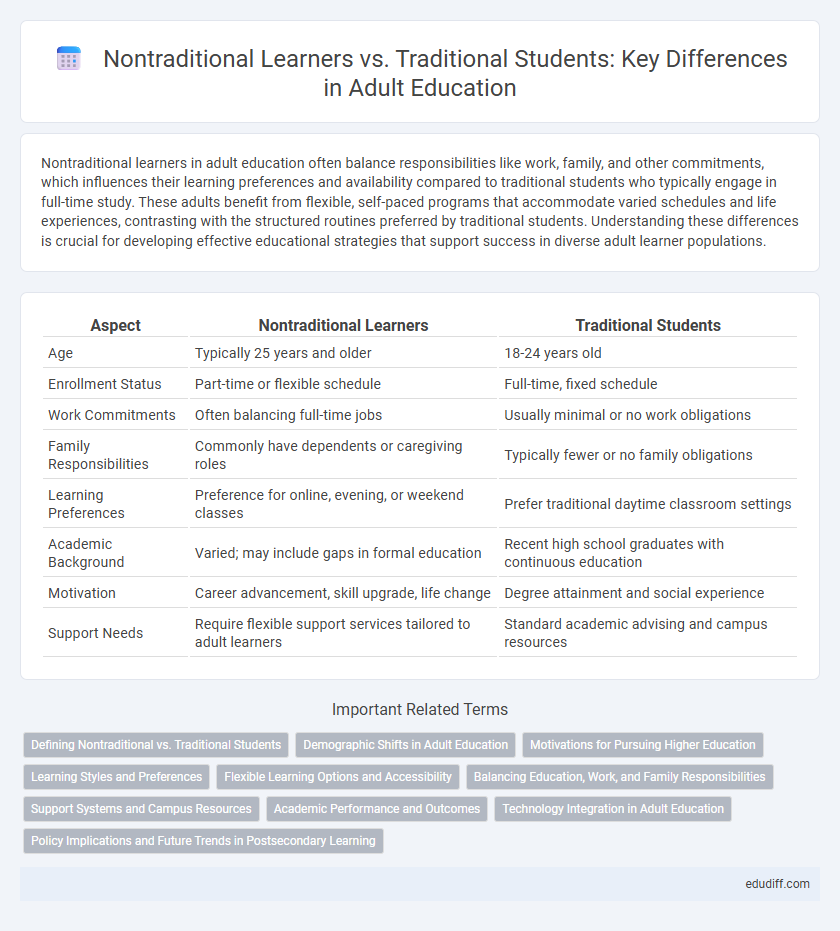Nontraditional learners in adult education often balance responsibilities like work, family, and other commitments, which influences their learning preferences and availability compared to traditional students who typically engage in full-time study. These adults benefit from flexible, self-paced programs that accommodate varied schedules and life experiences, contrasting with the structured routines preferred by traditional students. Understanding these differences is crucial for developing effective educational strategies that support success in diverse adult learner populations.
Table of Comparison
| Aspect | Nontraditional Learners | Traditional Students |
|---|---|---|
| Age | Typically 25 years and older | 18-24 years old |
| Enrollment Status | Part-time or flexible schedule | Full-time, fixed schedule |
| Work Commitments | Often balancing full-time jobs | Usually minimal or no work obligations |
| Family Responsibilities | Commonly have dependents or caregiving roles | Typically fewer or no family obligations |
| Learning Preferences | Preference for online, evening, or weekend classes | Prefer traditional daytime classroom settings |
| Academic Background | Varied; may include gaps in formal education | Recent high school graduates with continuous education |
| Motivation | Career advancement, skill upgrade, life change | Degree attainment and social experience |
| Support Needs | Require flexible support services tailored to adult learners | Standard academic advising and campus resources |
Defining Nontraditional vs. Traditional Students
Nontraditional students are typically defined by characteristics such as delayed enrollment after high school, part-time attendance, full-time employment, and independent financial status, contrasting with traditional students who enroll immediately after high school, attend full-time, and rely on parental support. These demographic and lifestyle differences impact academic needs, engagement, and resource utilization, requiring tailored educational approaches for nontraditional learners. Understanding these distinctions is essential for institutions aiming to support diverse student populations effectively.
Demographic Shifts in Adult Education
Demographic shifts in adult education reveal a growing population of nontraditional learners, including working adults, parents, and military veterans, who pursue higher education to advance their careers or change professions. Unlike traditional students typically aged 18 to 22, these learners often balance education with work and family responsibilities, requiring flexible schedules and online learning options. Institutions adapting to this trend implement targeted support services and tailored programs to address the unique needs of adult learners and improve retention rates.
Motivations for Pursuing Higher Education
Nontraditional learners pursue higher education driven by career advancement, skill enhancement, and personal fulfillment, often balancing work and family responsibilities alongside studies. Traditional students typically focus on academic achievement, social experiences, and establishing foundational career paths immediately after high school. Understanding these distinct motivations helps educational institutions tailor support services and flexible learning options to better meet diverse student needs.
Learning Styles and Preferences
Nontraditional learners often prefer self-paced, experiential, and practical learning styles that accommodate their responsibilities outside of education, such as work and family. Traditional students typically thrive in structured environments with linear curricula and scheduled class times that align with their routine availability. Understanding these distinct learning preferences allows educators to design inclusive programs that enhance engagement and success for both groups.
Flexible Learning Options and Accessibility
Nontraditional learners benefit significantly from flexible learning options such as online courses, evening classes, and self-paced modules that accommodate work and family commitments. Traditional students often follow structured, on-campus schedules, limiting their ability to adjust learning times to personal needs. Accessibility in education technology and adaptive resources further empower nontraditional learners to balance academic goals with other responsibilities, enhancing retention and success rates.
Balancing Education, Work, and Family Responsibilities
Nontraditional learners often juggle education with full-time employment and family caregiving, requiring flexible scheduling and support services to maintain academic progress. Traditional students typically focus primarily on coursework, benefiting from campus resources and structured class times. Effective balancing strategies for nontraditional learners include online courses, time management skills, and access to childcare facilities, which are critical for reducing dropout rates and promoting degree completion.
Support Systems and Campus Resources
Nontraditional learners often benefit from tailored support systems such as flexible counseling services, childcare facilities, and career counseling that accommodate their unique life circumstances compared to traditional students. Campus resources like online tutoring, evening classes, and veteran-specific programs are critical in bridging gaps for adult learners returning to education. Enhanced access to financial aid advisors and peer mentoring programs further empowers nontraditional students to navigate academic challenges effectively.
Academic Performance and Outcomes
Nontraditional learners often demonstrate higher resilience and time-management skills, leading to comparable or superior academic performance compared to traditional students. These learners typically balance education with work and family responsibilities, which fosters practical application of knowledge and enhanced problem-solving abilities. Studies indicate that nontraditional students frequently achieve positive academic outcomes, including higher retention rates and successful degree completion, when supported by tailored institutional resources.
Technology Integration in Adult Education
Nontraditional learners in adult education benefit significantly from technology integration, which provides flexible access to digital resources, asynchronous online courses, and interactive learning platforms tailored to diverse schedules. Traditional students often experience structured, campus-based instruction, whereas nontraditional learners leverage mobile apps, virtual classrooms, and adaptive learning technologies to balance education with work and family commitments. Technology-driven tools enhance engagement, personalized learning pathways, and real-time feedback, promoting higher retention rates and skill acquisition among adult learners.
Policy Implications and Future Trends in Postsecondary Learning
Nontraditional learners, often characterized by part-time enrollment, work commitments, and family responsibilities, require flexible policies that support asynchronous learning and credit for prior experience. Traditional students, typically full-time and campus-based, benefit from structured academic calendars and on-campus resources, highlighting the need for differentiated policy frameworks. Emerging trends in postsecondary education emphasize hybrid models, competency-based education, and expanded financial aid options tailored to diverse learner profiles, driving policy reforms toward inclusivity and adaptability.
Nontraditional learners vs Traditional students Infographic

 edudiff.com
edudiff.com